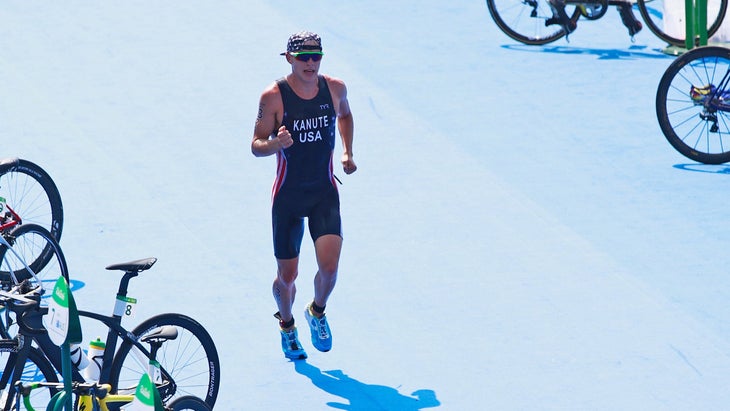Jeff Galloway almost certainly holds the record for a run-walk marathon — he ran a 2:16:35 at Houston in 1980 while taking a brief walk break each mile. It’s also his personal record, and it came eight years after he made the 1972 Olympic team in the 10,000m.
In 1978 Galloway remembers hitting a low point in his training and racing. He had injuries, suffered through races far slower than his expectations, and began feeling “down” about his running. “I thought, ‘Okay, maybe I’ve reached the end of my improvement curve,’” he recalls. “I wallowed in my misery for a bit, and then realized I needed a different goal. I came up with a new personal mantra: ‘Run Injury Free.’”
To achieve this, he began to incorporate run-walk sessions in his training. “My next several years were just stellar,” he says. At that 1980 Houston Marathon, he ran to each mile marker, then pulled over to the side of the road for a walk break. “It was embarrassing at the time,” he admits. But it worked, producing to a PR, and proving the method is not just for inexperienced neophytes.
A few years earlier, in 1973, Galloway had imposed an ironclad rule on his students in a beginning running course. He: “No huffing and puffing.” In other words, when you start feeling out of breath, stop running. Take a walk break.
That’s how it started. Since then, Galloway has spread the (as he calls it) to legions of runners, from beginners to aspiring sub-3:00 marathoners. His chief training officer, Chris Twiggs, says more than a million runners or walkers have interacted with Galloway in one form or another since 1973.
Nearly a half-century later, the run-walk movement is both going strong and morphing in several unexpected directions.
For one, it has been adopted by a handful of elite triathlon coaches and athletes. They say that run-walk training helps them build endurance while avoiding injuries — a combo that leads to faster performances. Second, the running and walking breaks are getting shorter. Galloway says many runners are now only taking 30-second or 15-second breaks, while beginners may now be running 5 seconds and walking 30 seconds. Why? Because it works for them.
Below you’ll find a summary of run-walk principles, workouts, and results from three veteran professional coaches, ending with Galloway himself. These summaries are based on extensive interviews with the coaches.
Elite Coach Bobby McGee’s “Fractionalized” Runs
Born in South Africa, but Boulder-based and a U.S. citizen for almost 20 years, coached distance legend Colleen DeReuck to four Olympic teams. He has concentrated on triathletes for much of the last decade, and worked with 2016 Olympic Triathlon gold-medalist Gwen Jorgensen to hone her running.
Always an honor to work with Gwen Jorgensen. Her level of commitment & attention to detail is a clear indicator of what makes her GREAT
— Bobby McGee Running (@BobbyMcGeeRun)
In recent years, McGee has used Galloway run-walk training with most of his top athletes. “I’m not a ‘supporter to some degree,’” he declares. “I am a total supporter.”
McGee often uses the term “fractionalized” in reference to the various run:walk ratios that his different athletes follow. A run-only workout is a whole number, maybe 60 minutes; a run-walk workout is “fractionalized,” as in 4 minutes running to 1 minute walking, which is then repeated 12 times to reach 60 minutes.
McGee excels at simple, strong explanations for his training beliefs. Here are a few of the key reasons why he endorses run-walk training:
- Many talented “high octane” runners have trouble maintaining sufficient weekly mileage and doing healthy long runs. When they switch to “fractionalized” run-walk long runs, they fare much better.
- Experience has shown that a allows runners to maintain pace more effectively, with less risk of muscle fatigue and bonking, than an all-run approach.
- On long runs where would normally gradually inch your heart rate upward, stressing the cardiovascular system — this happens especially in the heat — run-walk training provides an outlet that helps keep your heart rate in the desired range.
- The legs stay snappier, with less calf muscle cramping and more spring or “pop,” when they are allowed to recover during walk breaks. McGee says this has helped him increase the run-training mileage of Olympic-level triathletes without an equivalent increase in fatigue or injury risk.
- Big runners with muscular body types also have issues with long runs. McGee believes that run-walk gives them a better alternative.
McGee also notes that many midpack marathoners run too fast on their long runs. This can be corrected with a run-walk plan. According to his analysis, midpack and back-of-the-pack marathoners often do their long runs at about the same pace as their marathon goal pace. By contrast, elite marathoners run 40 to 60-seconds per mile slower on long runs than in marathon races. “With a run-walk plan for long runs, slower runners can settle into a much more sustainable pace,” McGee says. “This will allow them to recover better, get stronger, and run more efficiently in their other training.”
For a current 3:30 marathoner [about 8:00 minute/mile pace] who wants to try run-walk to improve marathon performance, McGee advises a faster midweek tempo-type workout. He likes five to seven repeats of 10 minutes each at 7:30 to 7:40 pace. Take a 60- to 90-second walk break between the repeats.
McGee acknowledges that it’s challenging to convince runners to accept walk breaks. Ego always intrudes. He says this is best surmounted through candid conversation pointing out that faster race finish times will burnish the ego, not bruise it. Veteran runners in particular come to see that run-walk is “another weapon in their fight against Father Time,” observes McGee.

Gaining a Risk/Reward Advantage
Coach admits that he was a “non believer” when he first heard the run-walk success stories. But when the former DI collegiate runner needed to get fit and lose 40 pounds a few years after his children were born, he tried it himself. The program worked so well that he soon introduced it to several elite triathletes he coaches. “Now I’m both an advocate and evangelist,” he says.
Vance’s best-known athlete is Ben Kanute, who made the U.S. 2016 Olympic Triathlon team, and finished second in the 2017 Ironman 70.3 World Championships. In working with Kanute and others, Vance has observed that run-walk training leads to a significant “risk reward advantage. You get less injury, better recovery, and consistent improvement with time.” He believes that his triathletes using run-walk have a “95 percent lower rate of soft-tissue injuries.”
Typically Vance suggests that runners switching to run-walk continue their current long-run time, say 90 minutes, but follow a ratio of four minutes running to one minute walking. As they become more comfortable with run-walk, they can experiment with other ratios: maybe 9:1 or even 14:1 Keeping each segment at a multiple of five minutes isn’t necessary or important; it’s just simple.
Once they have settled on the run-walk ratio they like best, Vance’s athletes often complete long runs as fast or nearly as fast as when they ran the whole distance. How is that possible? “Because of the walking-break recoveries, they go a bit faster while they’re running,” Vance explains. “I think this is one of the reasons for the lower injury rate. They’re maintaining good form. They’re breaking down less from the fatigue of nonstop running.”
Of course, elite athletes wouldn’t be elite if they didn’t want to run fast from time to time. Yes, Vance’s runners do interval training. And when they do, he makes sure they take some walk breaks between repeats. Typically, they’ll rest for two minutes, always beginning with 30- to 60-seconds of walking. Then they jog into the next repeat. “This way we make sure they are getting their heart-rate down low enough before the next fast repeat,” Vance says.
Run-walk represents a significant mental barrier for high-striving athletes. “I get a lot of push-back at first,” Vance admits. “But when someone sticks with it and sees the success they can have…. It’s good for all of us to learn something new. As a coach, I’d be doing a disservice to my athletes if I didn’t get them to try run-walk.”
Galloway’s New Flexible Ratios

When the mid-1990s second-running-boom brought waves of new runners to Galloway’s training programs, he began to experiment with his run-walk methods. The old way: Run to a water stop, then walk for a minute. Or perhaps run 4 minutes, walk 1. Try 2:1 if that suited you. Basically, everyone walked for a minute.
But then he heard reports that some liked to run less, and also walk less. In 2014, he asked his worldwide program directors to conduct a full-on experiment with their training groups. They alternated between 1-minute walk breaks, and 30-second breaks. “They reported back that their groups almost universally preferred 30-second breaks,” says Chris Twiggs. “Group members were able to stick together better on training runs, had fewer injuries, and set a lot of PRs in their goal races.”
Galloway now advises runners aiming for a 3:30 marathon to run 4 minutes, and walk 30 seconds. Or to run 2 minutes and walk 15 seconds. For those anticipating a 5:00 to 6:00 hour marathon, he recommends 30 seconds run, 30 seconds walk; or 15 walk:15 run.
His runners use the same ratio on their long runs, which they do at up to 2 minutes/mile slower than their marathon goal pace. This is the slowest marathon long-run recommendation you’ll find anywhere, but Galloway’s sticking with it. He notes that some training-group leaders run at 13:00 to 14:00 pace in training to tend their flocks, and then go sub-3-hours for the full marathon distance on race day.
For the more talented and ambitious, he suggests a midweek faster workout to find your own best run-walk ratio. This session might be 4 to 6 x 800, or 2-3 x 1 mile. Run it at your goal marathon pace, with walk breaks. Each week, try a different run-walk ratio. The one you find most comfortable and efficient is the one you should use in your marathon. Even if it’s run 3:17 and walk 43 seconds.
“Hey, quirky stuff happens,” Jeff notes. “I encourage people to go with it.”


